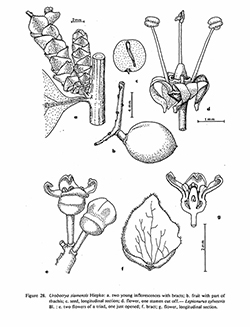e-Flora of Thailand
Volume 5 > Part 1 > Year 1987 > Page 100 > Opiliaceae > Lepionurus
Lepionurus sylvestris Blumewfo-0000443456
Bijdr.: 1148. 1826; Miq., Fl. Ind. Bat. 1.1: 784. 1856; Kurz, Fl. Burm. 2: 330. 1877; Valeton, Crit. Overz. Olac.: 153. 1886; Gagnep. In Fl. Gén. I.-C. 1: 806. 1911; Ridl., Fl. Malay Penins. 3: 172. 1924; Back. & Bakh.f., Fl. Java 2: 67. 1965; Hiepko, Nat. Hist. Bull. Siam Soc. 27: 123. f. 7. 1978; Willdenowia 9: 39. 1979; in Fl. Males., Ser. 1, Spermat. 10: 43. f. 9–11. 1984. Fig. 28: e–g.
Accepted Name : This is currently accepted.
Synonyms & Citations :
Description : Shrub, usually less than 1 m, rarely up to 4 m. Leaves extremely variable in shape, ovate, oblong, lanceolate or obovate, (5.5–)10–16(–25) by (1.5–)3–7(–9) cm [ratio 2–4(–10)]; apex acutely acuminate, base shortly attenuate or attenuate; petiole 1–5(–8) mm. Racemes 1–8 per axil; rhachis 2–4.5 cm (fruiting up to 6 cm). Bracts broadly ovate, acutely acuminate, 4–5(–6.5) by 3–5(–7.5) mm. Flowers 3 per bract, without bracteoles; pedicels 1–2 mm. Perianth-tube 0.5 mm long, resting on the cupular hypanthium. Perianth yellowish, 2–4.5 mm across; segments patent, ovate, acute. Stamens inserted below the margin of the disc; filaments as long as the perianth tube; anthers oval, 0.5 mm long. Pistil ca 1 mm long. Drupe orange-red, 9–16 by 6–10 mm; pedicel 2–2.5 mm.
Thailand : NORTHERN: Chiang Mai (Doi Chiang Dao, Doi Inthanon, Doi Suthep); PENINSULAR: Chumphon (Phato), Ranong (Khlong Nakha), Surat Thani (Ban Na, Khao Lang Tao, Khao Tha Phet, Ban Tong Tao), Nakhon Si Thammarat, Trang (Chong, Bang Sak, Kantang, Khao Phap Pha), Phatthalung (Sak), Songkhla (Khao Khieo), Pattani (Khao Khalakhiri), Yala (Betong).
Distribution : Nepal, Assam, Burma, S China, S Vietnam, Malay Peninsula, Sumatra, Borneo, W Java (type).
Ecology : In evergreen forests up to 1,250 m (Doi Suthep).
Vernacular : Mak mok (หมากหมก)(Peninsular).
Uses: Locally used as medicinal plant (root) for fever (Peninsular).

